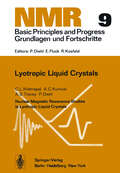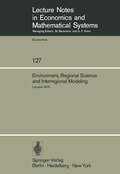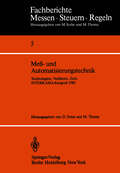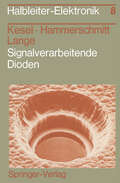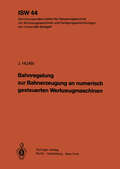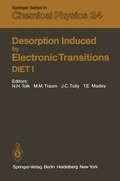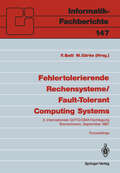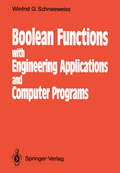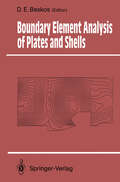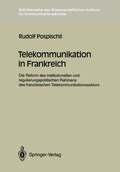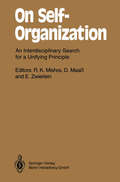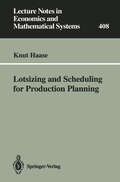- Table View
- List View
Nuclear Magnetic Resonance Studies in Lyotropic Liquid Crystals: Nuclear Magnetic Resonance Studies in Lyotropic Liquid Crystals (NMR Basic Principles and Progress #9)
by CL Khetrapal A. Kunwar A.S. Tracey P. Diehl1. Lyotropic Liquid Crystals The class of compounds known as thermotropic liquid crystals has been widely utilized in basic research and industry during recent years. The properties of these materials are such that on heating from the solid to the isotropic liquid state, phase transitions occur with the formation of one or more intermediate anisotropic liquids. The unique and sometimes startling properties of these liquid crystals are the properties of pure compounds. However, there exists a second class of substances known as lyotropic liquid crystals which obtain their anisotropic properties from the mixing of two or more components. One of the components is amphiphilic, containing a polar head group (generally ionic or zwitterionic) attached to one or more long-chain hydrocarbons; the second component is usually water. Lyotropic liquid crystals occur abundantly in nature, particularly in all living systems. As a consequence, a bright future seems assured for studies on such systems. Even now, many of the properties of these systems are poorly understood. It is the purpose of this review to consolidate the results obtained from nuclear magnetic resonance studies of such systems and to provide a coherent picture of the field. Probably the most familiar example of a lyotropic liquid crystal is soap in water. A common soap is sodium dodecylsulphate where an ionic group (sulphate) is attached to a hydrocarbon chain containing twelve carbons.
Environment, Regional Science and Interregional Modeling: Proceedings of the International Conference on Regional Science, Energy and Environment II, Louvain, May 1975 (Lecture Notes in Economics and Mathematical Systems #127)
by M. Chatterji P. Van RompuyThis second volume of proceedings of the International Conference on Regional Science, Energy and Environment (Louvain, May 1975) contains papers related to general and partial equilibrium models of regional and urban development, in which natural and human resources playa dominant role. It need not be stressed that environmental factors and resource management have,to some extent, been neglected in postwar economic research. Unfortunately, a world-wide energy crisis or more local environmental disruptions were necessary to draw the economist's attention on the increasing imbalance between man and environment. The topics treated in this volume reflect the shift in economic research which has taken place since the early seventies. They can be classified roughly into 4 fields. The first field deals with a welfare approach to environmental deterioration. The second area covers models of resource allocation that contain environmental constraints. The third class of problems focuses on the relationship between environment and urban development. Finally, some methodological papers are included that explore new areas in regional and ~nterregional model building. Klaassen opens this volume with a paper on the impact of rising energy prices on the structure of regional development and environment, He analyses the change in size of all potentials and the consequent decrease in the volume of traffic. Besides these short-run influences, a :reallocat{o~ of households and firms may be expected in the long-run.
Meß- und Automatisierungstechnik: Technologien, Verfahren, Ziele INTERKAMA-Kongreß 1980 (Fachberichte Messen - Steuern - Regeln #5)
by D. Ernst M. ThomaBahnregelung zur Bahnerzeugung an numerisch gesteuerten Werkzeugmaschinen (ISW Forschung und Praxis #44)
by J. HuanDesorption Induced by Electronic Transitions DIET I: Proceedings of the First International Workshop, Williamsburg, Virginia, USA, May 12–14, 1982 (Springer Series in Chemical Physics #24)
by N. H. Tolk M. M. Traum J. C. Tully T. E. MadeyThe Workshop on Desorption Induced by Electronic Transitions (DIET) took place May 12-14, 1982, in Williamsburg, Virginia. The meeting brought together, for the first time, most of the leading workers in the fields of electron and photon stimulated desorption from surfaces, as well as many workers in related fields, including sputtering, gas-phase photodissociation and solid-state theory. The emphasis of the workshop was on the microscopic mechanism of stimu lated desorption. Many possible mechanisms have been proposed, and a few new ones emerged at the meeting. Though no consensus was reached, many views were espoused and criticized, frequently with considerable enthusiasm. The result was an appraisal of our current understanding of DIET, and a focus on the experimental and theoretical efforts most likely to lead to new insights. This volume is an attempt to record the information exchanged in this very successful workshop and, perhaps, convey some of the excitement of the field of DIET. The book is a collection of papers written by participants in the DIET workshop, including in addition a contribution from Dietrich Menzel, who was unable to attend. Thus, this book represents a complete statement of the state of the art of experimental and theoretical studies of DIET and related phenomena. More importantly, it addresses the interesting unsolved problems, and suggests strategies for unraveling them. We acknowledge the assistance given by the other members of the organizing committee, A. E. de Vries, R. Gomer, M. L. Knotek, D. Menzel and D. P.
The Boundary Element Method Applied to Inelastic Problems (Lecture Notes in Engineering #1)
by J.C.F. TellesMolecular Orbitals and their Energies, Studied by the Semiempirical HAM Method (Lecture Notes in Chemistry #38)
by Einar Lindholm Leif AsbrinkThis treatment of molecular and atomic physics is primarily meant as a textbook. It is intended for both chemists and physicists. ·It can be read without much knowledge of quantum mechanics or mathematics, since all such details are explained-. It has developed through a series of lectures at the Royal Institute of Technology. The content is to about 50 % theoretical and to 50 % experimental. The reason why the authors, who are experimentalists, went into theory is the following. When we during the beginning of the 1970's measured photo electron spectra of organic molecules, it appeared to be impossible to understand them by use of available theoretical calculations. To handle hydrocarbons we ( together with C. Fridh ) constructed in 1972 a purely empirical procedure, SPINDO [1] which has proved to be useful, but the extension to molecules with hetero atoms appeared to be difficult. One of us ( L.A.) proposed then another purely ~~E!E!~~! EE2~~~~E~ ( Hydrogenic Atoms in Molecules, HAM/1, unpublished), in which the Fock matrix elements f5..y were parametrized using Slater's shielding concept. The self-repulsion was compensated by a term "-1". The §~~2~~_~ff2E~, HAM/2 [2] , started from the total energy E:. of the molecule. The atomic parts of L used the Slater shielding constants, and the bond parts of E. were taken from SPINDO. The Fock matrix elements Fpv were then obtained from E in a conventional way.
Progress in Botany: Structural Botany Physiology Genetics Taxonomy Geobotany / Fortschritte der Botanik Struktur Physiologie Genetik Systematik Geobotanik (Progress in Botany #47)
by H.-Dietmar Behnke Karl Esser Klaus Kubitzki Michael Runge Hubert ZieglerFehlertolerierende Rechensysteme / Fault-Tolerant Computing Systems: 3. Internationale GI/ITG/GMA-Fachtagung / 3rd International GI/ITG/GMA Conference Bremerhaven, 9.–11. September 1987 (Informatik-Fachberichte #147)
by Fevzi Belli Winfried GörkeLaser Diagnostics and Modeling of Combustion
Combution phenomena in practical applications are too complicated to understand quantitatively in terms of the intrinsic fundamental processes. This is why many academic investigations have been of little use in the design or improvement of practical combustion systems. During the last decade, experimental methods for obtaining local and instantaneous infomation have been developed. Also, modeling techniques, particularly those by numerical simulation have become promising. With these points as background, a special research project on "Dynamic Modeling and Laser Diagnosis on Combution" has been carried out from 1983 through the 1985 fiscal year, under a Grant-in-Aid from the Ministry of Education, Science and Culture of Japan. The research has focused on developing laser diagnostics and modeling techniques which could be useful for analyzing the details of processes in practical continuous and intermittent combution sysytem. More than sixty members from about thirty universities and a national laboratory joined in this project, covering mechanical, chemical, physical, electronics and computation researches. Members were divided into five subject groups: (1) Velocity measurments, (2) Spray and soot measurments, (3) Temperature and species concentration measurments, (4) Premixed combution modeling, and (5) Diffusion combution modeling. Besides group meetings, general meetings have been held twice every year and symposia were held six times during the period to promote the research project.
Boolean Functions: With Engineering Applications and Computer Programs
by Winfried G. SchneeweissModern systems engineering (e. g. switching circuits design) and operations research (e. g. reliability systems theory) use Boolean functions with increasing regularity. For practitioners and students in these fields books written for mathe maticians are in several respects not the best source of easy to use information, and standard books, such as, on switching circuits theory and reliability theory, are mostly somewhat narrow as far as Boolean analysis is concerned. Further more, in books on switching circuits theory the relevant stochastic theory is not covered. Aspects of the probabilistic theory of Boolean functions are treated in some works on reliability theory, but the results deserve a much broader interpre tation. Just as the applied theory (e. g. of the Laplace transform) is useful in control theory, renewal theory, queueing theory, etc. , the applied theory of Boolean functions (of indicator variables) can be useful in reliability theory, switching circuits theory, digital diagnostics and communications theory. This book is aimed at providing a sufficiently deep understanding of useful results both in practical work and in applied research. Boolean variables are restricted here to indicator or O/l variables, i. e. variables whose values, namely 0 and 1, are not free for a wide range of interpretations, e. g. in digital electronics 0 for L ==low voltage and 1 for H == high voltage.
E-Public: Strategien und Potenziale des E- und Mobile Business im öffentlichen Bereich (Xpert.press)
by P. Blaschke W. Karrlein B. ZypriesE-Business und Mobile Business verändern massiv die Art und Weise, wie viele Geschäftsprozesse in Unternehmen und Organisationen ablaufen. Dabei spielen diese Veränderungen in immer größerem Maße auch in den gesamten öffentlichen Bereich hinein, von der Verwaltung bis zur Regierung. E-Government oder E-Public sind Schlagworte, die nur dürftig die Herausforderungen bezeichnen, die sich dahinter für die Mitarbeiter wie auch für die Bürger und Unternehmen verbergen. Die Einführung neuer E-Business- oder -Mobile-Lösungen erfordert dabei eine Strategie für neue Prozessmodelle, um das Potenzial im öffentlichen Bereich zu nutzen. Die Besonderheit des Buches liegt in der praxisorientierten Darstellung strategischer und konzeptioneller Ansätze, die durch reale Praxisbeispiele unterstützt wird. Es geht gezielt auf die Situation des öffentlichen Sektors ein und zeigt, wie die notwendige Transformation zum E-Public-Sektor bewältigt werden kann.
IUTAM: A Short History
by Stephen JuhaszThis volume presents the historical development of IUTAM, which began in Innsbruck in 1922 where the first IUTAM conference took place. These conferences have been held every four years with great success: the next will take place in Grenoble in 1988. This volume is dedicated to Professor Theodore von Karman (1881-1963), who has contributed greatly to the foundation of IUTAM.
Climate and Development: Climate Change and Variability and the Resulting Social, Economic and Technological Implications
by Prof. Dr. H.-J. Karpe Prof. Dr. D. Otten Sergio C. TrinidadeThe Hamburg Congress on Climate and Development was conceived as a response to the worldwide interest on issues of climatic change and variability. It was intended as an interdisciplinary forum to bring together differing perceptions in a face to face dialogue. Even though concern over climate change has been on the international agenda of international interest became evident in the for over a decade, a new surge wake of two recent events. One was the widespread support received by the 1987 Brundtland Commission Report, Our Common Future, and the other was the 1988 Montreal Protocol on substances that deplete the ozone layer. Although the problem of the ozone layer related to a single category of sub stances (CFCs), it took many years and a dramatk discovery of the ozone hole in Antarctica to allow for a breakthrough leading to an international agreement. The problems associated with climatic change and variability are much more com plex and pervasive than those of the ozone layer, and a much wider range of national and international issues are involved. The discussions in the 1988 session of the General Assembly of the United Nations revealed a surge of interest and growing awareness of the international community of the issues involved. Before that, the June 1988Toronto Conference on "The Changing Atmosphere: Implications for Global Security" was a signifi cant effort in forging a consensus on desirable targets for global action.
Micro System Technologies 90: 1st International Conference on Micro Electro, Opto, Mechanic Systems and Components Berlin, 10–13 September 1990
by Herbert ReichlOn September 10-13, 1990, the first international meeting on Microsystem Technologies takes place at the Berlin International Congress Center. Most of the traditional congresses deal with themes that become more and more specific, and only a small part of the scientific world is reflected. The Micro System Technologies is attempting to take the opposite direction: During the last two decades the development of microelectronics was characterized by a tremendous increase of complexity of integrated circuits. At the same time the fields of microoptics and micromechanics have been developed to an advanced state of the art by the application of thin film and semiconductor technologies. The trend of the future development is to increase the integration density by combining the microelectronic, microoptic, and micro mechanic aspects to new complex multifunctional systems, which are able to comprise sensors, actuators, analogue and digital circuits on the same chip or on multichip-modules. Microsystems will lead to extensions of the field of microelectronic applications with important technical alterations and can open new considerable markets. For the realization of economical solutions for microsystems a lot of interdisciplinary cooperation and know-how has to be developed. New materials for sensitive layers, substrates, conducting, semiconducting, or isolating thin films are the basis for the development of new technologies. The increasing complexity leads to increasing interaction among electrical and non-electrical quantities.
Semiconductors: Group IV Elements and III-V Compounds (Data in Science and Technology)
by Otfried MadelungThe frequent use of well known critical data handbooks like Beilstein, Gmelin and Landolt Bornstein is impeded by the fact that merely larger libraries - often far away from the scientist's working place - can afford such precious collections. To satisfy an urgent need of many scientists for having at their working place a comprehensive, high quality, but cheap collection of at least the basic data oftheirfield of interest the series "Data in Science and Technology"is started now. This first volume presents the most important data on two groups of semiconductors, the elements of the IVth group of the periodic system and the III-V compounds. All data were compiled from information on about 2500 pages in various volumes of the New Series of Landolt-Bornstein. For each critically chosen data set and each figure the original literature is cited. In addition, tables of content refer to the handbooks the data were drawn from. Thus the presentation of data in this volume is of the same high quality standard as in the original evaluated data collections. We hope to meet the needs of the physical community with the volumes of the series "Data in Science and Technology", forming bridges between the laboratory and additional information sources in the libraries.
Elementary Introduction to Spatial and Temporal Fractals (Lecture Notes in Chemistry #55)
by L.T. Fan D. Neogi M. YashimaFractals play an important role in modeling natural phenomena and engineering processes. And fractals have a close connection to the concepts of chaotic dynamics. This monograph presents definitions, concepts, notions and methodologies of both spatial and temporal fractals. It addresses students and researchers in chemistry and in chemical engineering. The authors present the concepts and methodologies in sufficient detail for uninitiated readers. They include many simple examples and graphical illustrations. They outline some examples in more detail: Perimeter fractal dimension of char particles, surface fractal dimension of charcoal; fractal analysis of pressure fluctuation in multiphase flow systems. Readers who master the concepts in this book, can confidently apply them to their fields of interest.
Boundary Element Analysis of Plates and Shells (Springer Series in Computational Mechanics)
by Dimitri E. BeskosInteractive Fuzzy Optimization (Lecture Notes in Economics and Mathematical Systems #368)
by Mario Fedrizzi Marc RoubensThe title of this book seems to indicate that the volume is dedicated to a very specialized and narrow area, i. e. , to the relationship between a very special type of optimization and mathematical programming. The contrary is however true. Optimization is certainly a very old and classical area which is of high concern to many disciplines. Engineering as well as management, politics as well as medicine, artificial intelligence as well as operations research, and many other fields are in one way or another concerned with optimization of designs, decisions, structures, procedures, or information processes. It is therefore not surprising that optimization has not grown in a homogeneous way in one discipline either. Traditionally, there was a distinct difference between optimization in engineering, optimization in management, and optimization as it was treated in mathematical sciences. However, for the last decades all these fields have to an increasing degree interacted and contributed to the area of optimization or decision making. In some respects, new disciplines such as artificial intelligence, descriptive decision theory, or modern operations research have facilitated, or even made possible the interaction between the different classical disciplines because they provided bridges and links between areas which had been developing and applied quite independently before. The development of optimiiation over the last decades can best be appreciated when looking at the traditional model of optimization. For a well-structured, Le.
Telekommunikation in Frankreich: Die Reform des institutionellen und regulierungspolitischen Rahmens des französischen Telekommunikationssektors (Schriftenreihe des Wissenschaftlichen Instituts für Kommunikationsdienste #13)
by Rudolf PospischilOn Self-Organization: An Interdisciplinary Search for a Unifying Principle (Springer Series in Synergetics #61)
by R. K. Mishra D. Maaß E. ZwierleinUltra-wideband Coherent Optical LANs (Research Reports Esprit #1)
by S. ForcesiThe content of this book is the result of the work and the experiences of an interdisciplinary and strictly European group of researchers who have attempted to give birth to a new fibre communication network concept by exploiting the potential benefits of optical coherent transmission. The run towards this ambitious goal started in 1985 on the basis of the ESPRIT program incentives by an "ad hoc" consortium of industrial partners and research institutions. The first three years were dedicated to a feasibility study carried out by a reduced number of "pioneers". In 1989 the team was extended to eleven partners. There was already clear evidence of the increasing interest in Europe in exploring the actual limits of optical fibre coherent systems; the project had innovative and very advanced features that were gradually refined by incorporating the latest technological developments to which it has directly contributed. The main objective of the project targeted the development of the necessary building blocks to show experimentally the performance and the flexibility built into the proposed concept of multi-channel ultra-wideband network. The system concept developed within this project associates optical frequency division multiplexing with a suitable network architecture and management techniques to allow very high flexibility and efficiency in handling simultaneous transmission over the network (on each optical frequency) of multiple virtual channels each operating with a wide range of information rates ranging from a fraction of a Mb/s up to a maximum value in excess of 160 Mb/s.
Lotsizing and Scheduling for Production Planning (Lecture Notes in Economics and Mathematical Systems #408)
by Knut HaaseBillions of dollars are tied up in the inventories of manufacturing companies which cause large (interest) costs. A small decrease of the inventory and/or production costs without reduction of the service level can increase the profit substantially. Especially in the case of scarce capacity, efficient production schedules are fundamental for short delivery time and on-time delivery which are important competitive priorities. To support decision makers by improving their manufacturing resource planning system with appropriate methods is one of the most of production planning. interesting challenges The following chapters contain new models and new solution strategies which may be helpful for decision makers and for further research in the areas of production planning and operations research. The main subject is on lotsizing and scheduling. The objectives and further characteristics of such problems can be inferred from practical need. Thus, before an outline is given, we consider the general objectives of lotsizing and scheduling and classify the most important characteristics of such problems in the following sections.
Entwicklung der Telekommunikation in den neuen Bundesländern: Beispiel einer erfolgreichen Strukturanpassung (Schriftenreihe des Wissenschaftlichen Instituts für Kommunikationsdienste #16)
by Thomas Schnöring Uwe SzafranKommunikationsinfrastrukturen sind eine wichtige Voraussetzung für die wirtschaftliche und gesellschaftliche Entwicklung. Dieses Buch untersucht den Telekommunikationssektor in Ostdeutschland. Nach der Wende zeigte sich die ostdeutsche Telekommunikationsinfrastruktur zunächst als gravierendes Hemmnis für einen raschen wirtschaftlichen Aufschwung, in den Jahren danach wurden deutliche Fortschritte erreicht. Das Buch analysiert die Entwicklung des Sektors in der DDR vor der Wende, die Telekommunikationspolitik der Bundesregierung, die Entwicklung des Angebots der Telekom und ihrer privaten Wettbewerber sowie die Versorgung und die Zufriedenheit von Wirtschaft und Privathaushalten mit Telekommunikationsdiensten.
